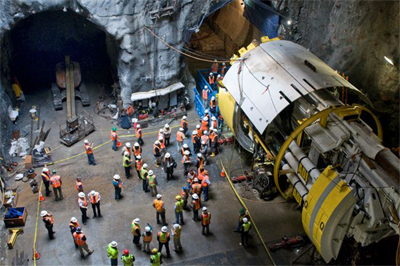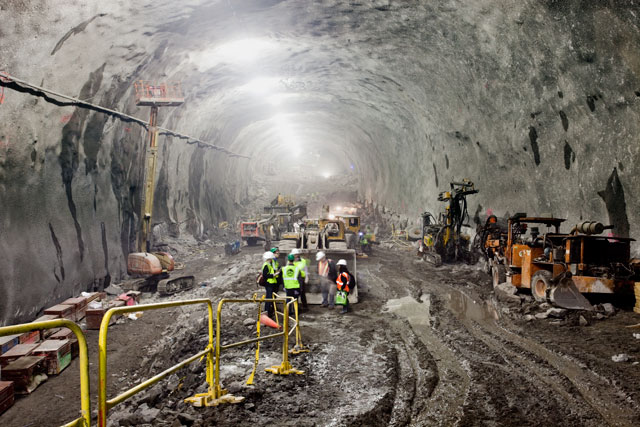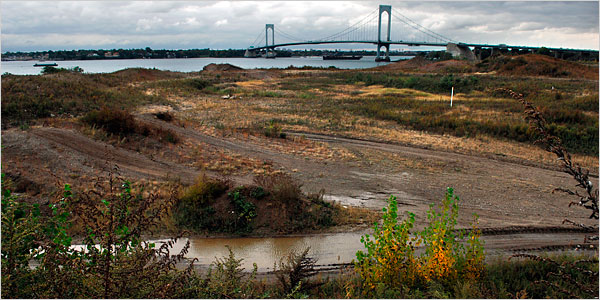 As progress on the much-delayed Second Avenue subway line creeps along, one question has undoubtedly occurred to the many New Yorkers who witness the queues of dump trucks arriving and departing every day: “What do they do with all the rocks and dirt that are excavated from the site?”
As progress on the much-delayed Second Avenue subway line creeps along, one question has undoubtedly occurred to the many New Yorkers who witness the queues of dump trucks arriving and departing every day: “What do they do with all the rocks and dirt that are excavated from the site?”
Colloquially known as muck, hundreds of thousands of pounds of this stuff are to be excavated by project’s end. To give an idea of the scale of the project, just the planned 72nd Street station alone, which is being excavated from solid rock, is estimated to yield 375,000 cubic yards of muck. This amounts to 40 to 70 truckloads a day, with each truck having a carrying capacity of about 20 tons. What does the city do with all this stuff? Well, as it happens they can do quite a bit with it.
In fact, the New York that we know and love today is the result of generations of recycled muck being put to good use.
New York is a city known world-wide for its vertical expansion. The fact that Manhattan is an island, and that its borders were reached generations ago, means that the city has no where to expand but up. Well, actually this isn’t entirely true. It might surprise some people to learn that the island of Manhattan has itself expanded to accommodate the demands of an ever increasing population and this expansion was made possible by using the muck from massive construction projects like our subway system.
For example, from 1896 all the way through to 1964, historic Ellis Island was continually expanded by landfill. What used to be a tiny five acre island now measures thirty-two acres, due primarily to the muck from the construction of the lettered subway lines in the 1930’s.
Governor’s Island, originally 90 acres, was enlarged to its current 172 acres by muck from the construction of the Lexington Avenue subway line deposited on its southern end in the early 1900’s. The excavation for the foundation of the World Trade Center created enough landfill to not only expand Battery Park further into the harbor, but also create all of the land now known as Battery Park City, one of the most expensive and highly developed residential districts in the city, bringing in millions in tax revenue from land that was literally created from nothing. Landfill is even used in building great monuments and works of art throughout the city. The Cathedral of St. John the Divine on the Upper West Side of Manhattan is largely built from rock excavated from the construction of the #1 line in 1904.
So with such an illustrious pedigree of profiting by reappropriation one would expect nothing less from today’s modern engineers and city planners. Unfortunately that doesn’t seem to be quite the case. Or at least not on the same scale as past projects.
There are actually three major rail projects under way in the City right now: the Second Avenue subway line, the LIRR tunnel under the East River, and the extension of the 7 line to the far West Side. By their completion these projects will have produced hundreds of thousands, if not millions of tons of muck, which has to be disposed of somewhere.
In the case of the LIRR tunnel some of this muck was used to construct the landscaping in Brooklyn Bridge Park. Though the project is ongoing, the parts that have been completed are an amazing testament to the power of dynamic urban design. In the case of the Second Avenue subway line, some of it is being used in the construction of the new Ferry Point Golf Course in the Bronx. Both of these projects add economic value to the city’s real-estate, generate revenue through business and taxes, and provide much needed public space for rest and recreation. Not to mention the aesthetic value that carefully designed green space with its rolling hills and meandering paths adds to the austere rectilinearity of the city’s landscape.
Some of the muck is also crushed and sold for further use as building material in construction and landscaping, but the city does not directly profit from this business, as it is all conducted by private enterprise. Disappointingly, it doesn’t seem as if any of the muck is being used to add to the overall land mass of the city and it’s environs, as in the past, but it is being used for land reclamation in some sites in NY and NJ in addition to the above mentioned building material. None of it is actually wasting away in a landfill. But considering New York’s successful history of recycling precious excavation material, maybe new uses will be found before this round of digging is through.



3 Comments
Comments are closed.